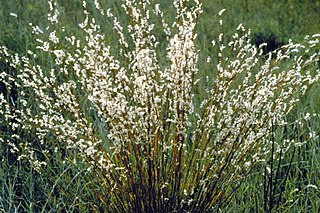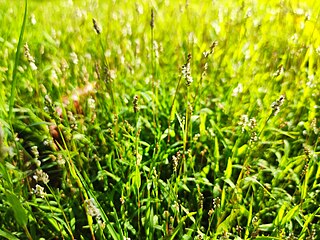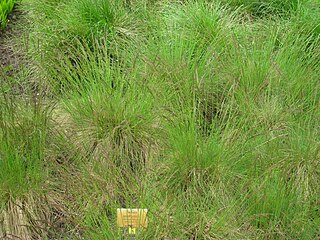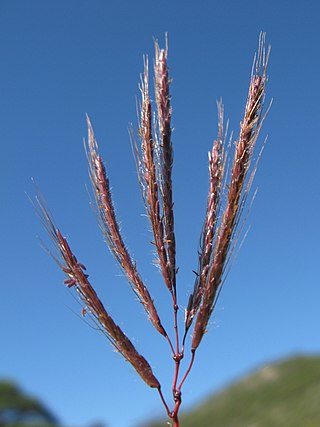
Avena is a genus of Eurasian and African plants in the grass family. Collectively known as the oats, they include some species which have been cultivated for thousands of years as a food source for humans and livestock. They are widespread throughout Europe, Asia and northwest Africa. Several species have become naturalized in many parts of the world, and are regarded as invasive weeds where they compete with crop production. All oats have edible seeds, though they are small and hard to harvest in most species.

Saccharum is a genus of tall perennial plants of the broomsedge tribe within the grass family.

The Andropogoneae, sometimes called the sorghum tribe, are a large tribe of grasses (family Poaceae) with roughly 1,200 species in 90 genera, mainly distributed in tropical and subtropical areas. They include such important crops as maize (corn), sugarcane, and sorghum. All species in this tribe use C4 carbon fixation, which makes them competitive under warm, high-light conditions.

Pennisetum is a widespread genus of plants in the grass family, native to tropical and warm temperate regions of the world. They are known commonly as fountaingrasses. Pennisetum is considered a synonym of Cenchrus in Kew's Plants of the World Online.

Poa is a genus of about 570 species of grasses, native to the temperate regions of both hemispheres. Common names include meadow-grass, bluegrass, tussock, and speargrass. Poa is Greek for 'fodder'. Poa are members of the subfamily Pooideae of the family Poaceae.

Furcraea foetida is a species of flowering plant native to the Caribbean and northern South America. It is widely cultivated and reportedly naturalized in many places.

Acroceras is a genus of tropical and subtropical plants in the grass family.

Alloteropsis is a genus of Old World plants in the grass family.

Chrysopogon is a genus of tropical and subtropical plants in the grass family. They are widespread across Eurasia, Africa, Australia, southeastern North America, and various islands.

Urochloa, commonly known as signalgrass, is a genus of plants in the grass family, native to tropical and subtropical regions of Eurasia, Africa, Australia, the Americas, and various islands.

Aegilops neglecta, common name three-awn goat grass, is a species in the family Poaceae.

Beckmannia eruciformis, the European slough-grass or slough grass, is an annual or short lived perennial in the grass family, Poaceae, found in shallow marshes or sloughs, and used for animal fodder and forage.

Bouteloua hirsuta, commonly known as hairy grama, is a perennial short prairie grass that is native throughout much of North America, including the Great Plains and Canadian Prairies region, as well as Mexico and Guatemala.

Cleistogenes serotina is a species of grass in the family Poaceae, native to Europe and temperate Asia. Culms are geniculately ascending, 1 mm in diameter, and 30–60 cm in height. Leaf-blades are spreading, flat, or involute, from 4–8 cm long and 3–5 mm wide.

Festuca amethystina, also known as the tufted fescue, is a species of grass in the family Poaceae. It is native to Europe, including Turkey. It is perennial and grows in temperate biomes. It was first described in 1753 by Carl Linnaeus.

Desmostachya bipinnata, commonly known as halfa grass, big cordgrass, and salt reed-grass, is an Old World perennial grass, long known and used in human history. The grass is tall, tufted, leafy, perennial grass, branching from the base, erect from a stout creeping rootstock.

Dichanthium annulatum is a species of grass in the family Poaceae. It is commonly used as a forage for livestock.
Chrysopogon nigritanus, more widely known by the taxonomic synonym Vetiveria nigritana, or the common name black vetivergrass, is a perennial grass species of the family Poaceae and therefore is also a monocotyledon. More specifically, Vetiveria nigritana is a very thick and tall type of grass that is deeply rooted within the ground and is usually used to protect crops and deter soil erosion. Vetiveria nigritana is also a native species to Africa and is most commonly seen in Nigeria, Northern Africa, Eastern Africa and tropical parts of Southern Africa. In addition, the plant, like other vetiver grasses, has been used in these regions due to its extreme drought tolerance, ability to grow in infertile soil and the fact that it can live under complete submergence. In fact, Vetiveria nigritana can thrive in a very diverse range of environmental and climatic conditions.

Chrysopogon fallax is a perennial tufted grass endemic to Australia found in all mainland states except Victoria. It is commonly known as golden beard grass, ribbon grass, and weeping grass.


















